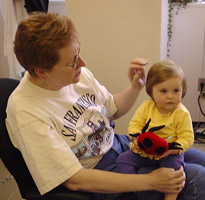

Erica with Dot Houchens and ladybug
|
Hugh Robertson The
past 2 years have seen a complete turnover of students in my lab, a major new research
focus pick up steam, and my personal life take a turn for the better. My long-term
postdoc, David Lampe, who had completed his Ph.D. here with Judy Willis before joining my
lab, accepted an assistant pro-fessor position at Duquesne University in Pittsburg. We
miss his expertise greatly, but he managed to get a lot done here, most significantly
demonstrating that our mariner transposons can function independently of host cell
factors. They are therefore potentially universal genetic vectors, something that is
holding up well with demonstration of activity in human cells, Archaebacteria, and good
old E. coli. The latter allowed him to develop a screen for hyperactive mutants of
the mariner transposase in hopes of obtaining sufficiently active versions that
might work well for insects, and renew our NIH funding for this work, which is now split
between our labs. Our technician Kim Walden, a masters student in my lab who debunked
claims of amplification of DNA from amber fossil bees, has taken the lead on our remaining
mariner project, that is, their distribution in mammals and other vertebrates, and
contribution to novel fusion genes in the human genome, another NIH-funded project.
Rosanna Giordano, Felipe Soto-Adames, and Chun-Liang Chen
all finished up their Ph.D.’s and moved on to postdoctoral positions elsewhere. Their
departures essentially end our efforts on the Wolbachia bacteria that cause
cytoplasmic incompatibility, insect molecular phylogenies, and studies of P elements
beyond the Drosophilidae, respectively. Rosanna and Felipe spent a year at the University
of Connecticut with Chris Simons before moving on to the University of Vermont with Jan
Conn, and continue to pursue related projects. Chun-Liang moved to Ohio State to work on Drosophila
neurobiology.
Our new research focus is the search for the elusive insect
olfactory receptor proteins. In collaboration with James Nardi, we obtained funding from
the University Research Board, then NSF, and now a local fund for a major effort involving
Expressed Sequence Tag surveys of genes expressed in insect antennae. This approach has
proven very successful for the various model organisms, although we are not undertaking it
at those scales (we sequence the ends of hundreds versus tens of thousands of cDNA
clones). Our first project involving Manduca sexta male antennae yielded no
clear receptor candidates, but did reveal a higher diversity of odorant binding proteins
expressed in moth antennae than known before, and together with preliminary results from
the Drosophila genome project strongly suggests that there are large families of
these small secreted proteins that might act as filters in the sensilla. This work was
carried out by a group of undergraduate students, and I finished the first manuscript over
the holiday break. Another group of undergraduates has carried out a second project on
female antennae, while several new graduate students, Ellen Todres, Karlene Ramsdell, and
Harland Patch are undertaking similar projects on honey bees, western corn rootworms, and
black swallowtail butterflies, respectively.
On the personal side, my wife Christina and I endured the
stillbirth of our son, nicknamed Wiggles, on his due date in March 1997. We took my
stepson Gabriel with us to South Africa that summer to visit my parents who have retired
in Cape Town. We also got to visit Etosha National Park in Namibia, some of my old haunts
in Johannesburg, and my sister and more wildlife parks in Natal. Then our daughter Erica
was born May 1, 1998, and I’ve not quite recovered yet. She’s been a delight,
and is now walking. She’s survived many trips already, including a summer month
visiting my brother’s family in Hawaii and Christina’s family in Seattle. This
winter Erica enjoyed all the snow we had, and we look forward to a road trip to visit
friends on the East Coast after this semester, and then to Europe with her and Gabriel
this summer to visit Christina’s relatives in Sweden and mine in Scotland. |
